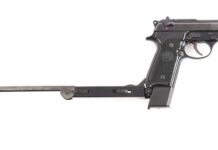
The single stack 9mm world exploded when S&W released the Shield. The Shield is currently one of the best budget guns on the market, but during its introductions, it was so sought after and so popular that it was selling for well above MSRP. It was the first massively successful single stack 9mm, but it wasn’t the first. The Walther PPS wasn’t the first either, but it was one of the first from a major company that utilized the modern single stack 9mm layout.

The Walther PPS was a polymer frame, striker-fired pistol that was an inch wide. It’s 1.1 inches and includes the slide release. That 1-inch wide grip quickly became the new standard for concealable 9mm handguns. The original PPS, now called the M1, was a hidden gem amongst concealed 9mms. As a natural contrarian, I was drawn to it. I retried the gun in 2018 with the release of the SIG P365.
As I was going through the gun safe, I stumbled across my old friend, and it inspired me to regale you with the tale of the little Walther, a truly forgotten innovator in the firearms field.
The Walther PPS – Walther Did It First
The Walther PPS integrated the single stack 9mm design and purposefully aimed to make the gun slim. PPS stands for Police Pistol Slim. It can be seen as a continuation of the Walther PP/PPK series of pistols for the modern market. In the later James Bond novels, it’s Bond’s MI6-issued pistol.
Walther had a neat idea for a modern grip design. Users swapped the rear panels to change the grip size, but changing magazines could also affect grip size. Walther offered three magazine sizes: short, mid, and long. The short, flush-fitting magazine gave the user six rounds of 9mm. The mid extended the grip to eliminate the hanging pinky and offered seven rounds. Finally, the long gave you eight rounds and a Glock 19-length grip.

It was neat to see, and I don’t think any other single stack 9 used this type of grip design. The Walther PPS used a trigger guard magazine release, which is very European. I like it, especially on small guns. Sadly, it was ditched on the PPS M2. The gun has simple three-dot sights, no manual safety, and a one-slot rail for the smallest of accessories.
In 2007, when the gun was introduced, I didn’t think the lights were small enough to fit that rail, so it seemed to be intended for lasers. The PPS formed a simple concealed carry option, and while it predated the Shield by five years, it never exploded in popularity.

What’s Wrong With the PPS?
First, in the United States Walther seems to only be known for the PPK series of guns. A lot of awesome pistols are widely ignored. Guns like the P99 don’t ever get the credit they deserve. Walther just doesn’t have the same brand awareness or success with police forces. Or didn’t? It seems the PDP is doing an outstanding job.
The Walther PPS never took off. I can see why it didn’t pass the feel test for a lot of shooters. The magazine release as a whole isn’t going to be favored by American audiences. It’s never caught on here, regardless of how much Walther and HK push it.

The grip also kind of feels like a 2×4. It’s all corners, and while slim, it doesn’t feel superbly ergonomic. The PPS M2 fixed that and rounded some things out to make the grip a good bit more comfortable. By 2012, the majority of states had shall issue concealed carry, and in 2007, not only was it less common, people also just didn’t get their concealed carry permits as often.
In 2007, I knew one guy with a CCW permit, but by 2012, my mom had one. They were a little too early to be massively successful, mixed with the lack of brand recognition. S&W also benefitted from the new world of gun media. Gun tube, a modern firearms website, and what’s normal now wasn’t normal then. Gun reviewers like me couldn’t proclaim it as a game changer.
How’s It Handle?
The Walther PPS handles like every other small 9mm. Or like most. The PPS has got a slightly snappy recoil. It’s a bit tougher on the hand due to the four corners you’re gripping. It’s aggressively textured with this block-like grip texture. As a result, it stays put, and the high grip allows for maximum control.
The gun is plenty accurate for a small gun. It’s not exceptional, but C zone hits at 25 yards are easy. The Walther PPS eats basically anything you put through it. I’ve only ever seen it choke on steel-cased Winchester Forged ammo. I got a failure to extract once. That was a long time ago.

Oh dear, I have no idea how many rounds downrange it has, but a ton. It was my carry gun for about six years, so it saw a lot of lead. These days, it’s happy in retirement, but I wouldn’t feel unsafe firing it up again if need be.
The Walther PPS never got the credit it deserved. Walther attempted to revive the PPS line with the M2. They broke ground by including a mounted RMSc optic. As far as I know, this was the first time I saw a major company that had an optically enhanced small gun.

Sadly, there is no M3. If Walther brought out an M3, with the trigger guard magazine release, optic-ready compatibility, and a stack-and-half style magazine, I’d be a buyer. How else would I be a contrarian?



